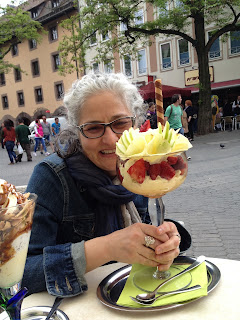 |
| At the Nuremberg Castle |
Sunday, May 31, 2015
May 17: The Nuremberg Castle
May 16: Nuremberg: Wandering through the City
 |
| Professor Tambasis and her typical daily Eis |
Saturday, May 30, 2015
May 16: Nuremberg and National Socialism, Part II
 |
| Inside the Courtroom |
Immediately
after the tour was over the group rushed to see the the Nuremberg Trial Memorial and Palace of Justice, a large
court complex that was home to one of the most infamous court cases in history. Immediately following the conclusion of the war, 23 high ranking German officials and officers were tried by an international
military tribunal for war crimes committed during World War II. Nuremberg’s court
was chosen both because of its massive size which allowed enough offices and space for all of the representatives from various respective countries involved and because it had escaped total destruction from Allied bombs.
May 16: Nuremberg and National Socialism, Part I
 |
| Former Congress Hall at the Rally Grounds |
to aid the Nazi party's goal.
May 15: Munich and National Socialism: Part II
 |
| Dachau |
Friday, May 29, 2015
May 15: Munich and National Socialism: Part I
 |
| The NS Documentation Center in Munich |
the Nazi state could create a racially pure empire.
Thursday, May 28, 2015
May 14: Bavaria's Fairytale Castles (or sir, please, can I have two minutes?)
Wednesday, May 27, 2015
May 13: First Impressions of Munich
 | |||
| Marienplatz (Altes Rathaus and Frauenkirche) |
May 13: From Frankfurt to Munich: Arrival in Germany
 |
| Train Station at the Frankfurt Airport |
Tuesday, May 26, 2015
WJU 2015: Bavaria and Austria
 It is time again for the Wheeling Jesuit University History
It is time again for the Wheeling Jesuit University History Department's annual May trip. 26 students, alumni, and faculty left May 12 for a nine day trip through Central Europe, with stops in Munich, Nuremberg, and Salzburg. As is our usual practice, the blog will be updated by history students describing their experiences and impressions of the trip. Our initial post for this year's trip follows after the jump.
Saturday, May 9, 2015
WJU's Commencement 2015
The Wheeling Jesuit History Department would like to congratulate the following seniors who graduated today with history majors: Jared Baranowski, Steve Bridgeman, Tori
Fluharty, Kara Gordon, Nick Malarbi, Marque Marry and Hunter Onderko.
They were a good group of students and people who represent what we
would like our students to be when they graduate from our university.
Subscribe to:
Comments (Atom)

